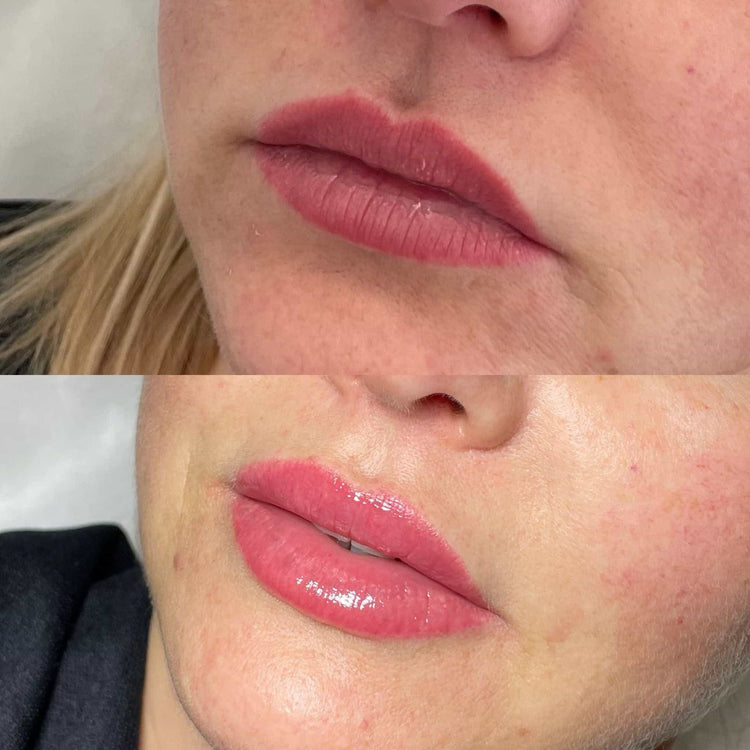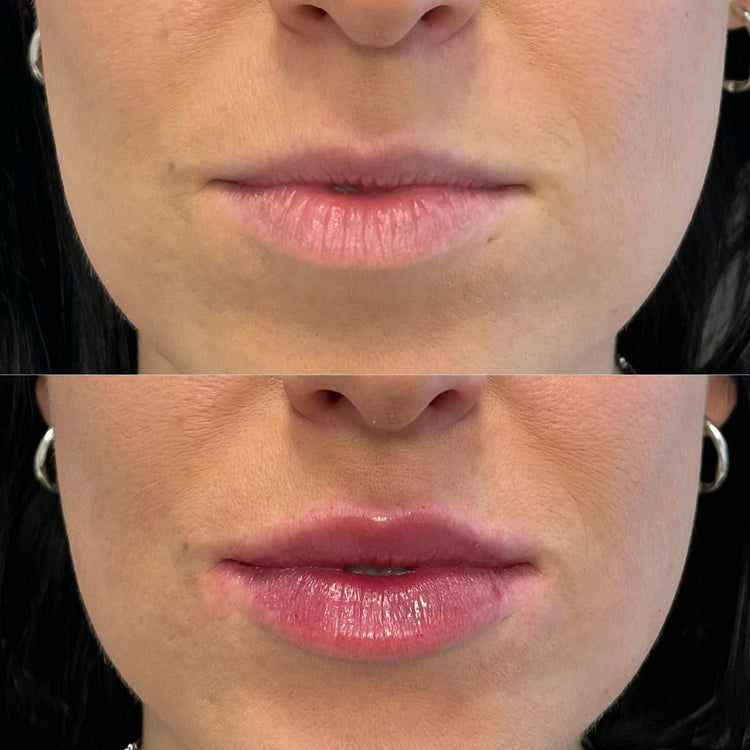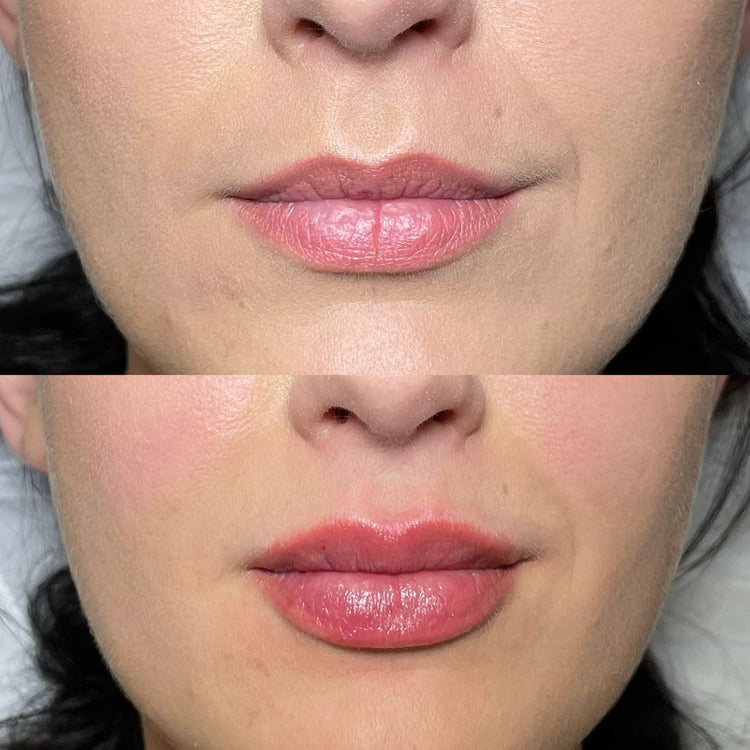Factors Affecting Filler Lifespan
Determining how long lip fillers last in the UK can be tricky as several factors influence their lifespan. Individual metabolism, lifestyle choices, and the type of filler used all play a role in how long you can expect your plump lips to stay that way.
Type of Filler
The longevity of lip fillers varies greatly depending on the specific type of filler injected. Hyaluronic acid-based fillers, the most common type used in the UK, tend to last between 6 to 18 months. These fillers work by attracting and retaining moisture, gradually breaking down over time as your body naturally reabsorbs them.
Other types of fillers, such as poly-L-lactic acid (PLLA), stimulate collagen production and can last longer, up to two years or more. However, PLLA fillers typically involve a series of injections for optimal results.
It’s important to note that these are general guidelines and your individual results may vary.
Injection Technique
Injection technique also significantly impacts the longevity of lip fillers. A skilled practitioner will inject the filler strategically, distributing it evenly and avoiding any bunching or migration. Proper placement ensures a natural look and helps prevent premature breakdown of the filler.
Furthermore, post-treatment care is crucial for maximizing filler lifespan. Avoiding excessive sun exposure, smoking, and facial massage can help maintain the shape and longevity of the results. It’s essential to follow your practitioner’s instructions carefully and attend any recommended follow-up appointments.
Individual Body Metabolism
Individual body metabolism plays a significant role in how long lip fillers last. Those with faster metabolisms tend to break down the filler more quickly, resulting in shorter-lasting results. Conversely, individuals with slower metabolisms may experience longer-lasting effects.
Lifestyle factors can also influence filler longevity. Smoking, excessive sun exposure, and frequent facial massage can all contribute to faster breakdown of the filler material.
Lifestyle Factors
Individual body metabolism plays a significant role in how long lip fillers last. Those with faster metabolisms tend to break down the filler more quickly, resulting in shorter-lasting results. Conversely, individuals with slower metabolisms may experience longer-lasting effects.
Lifestyle factors can also influence filler longevity.
- Smoking
- Excessive sun exposure
- Frequent facial massage
Average Lifespan
The duration lip fillers remain effective varies significantly depending on various factors specific to each individual and the treatment itself.
Hyaluronic Acid Fillers
Determining how long lip fillers last in the UK can be tricky as several factors influence their lifespan. Individual metabolism, lifestyle choices, and the type of filler used all play a role in how long you can expect your plump lips to stay that way.
The longevity of lip fillers varies greatly depending on the specific type of filler injected. Hyaluronic acid-based fillers, the most common type used in the UK, tend to last between 6 to 18 months. These fillers work by attracting and retaining moisture, gradually breaking down over time as your body naturally reabsorbs them.

Other types of fillers, such as poly-L-lactic acid (PLLA), stimulate collagen production and can last longer, up to two years or more. However, PLLA fillers typically involve a series of injections for optimal results.

It’s important to note that these are general guidelines and your individual results may vary.
Injection technique also significantly impacts the longevity of lip fillers. A skilled practitioner will inject the filler strategically, distributing it evenly and avoiding any bunching or migration. Proper placement ensures a natural look and helps prevent premature breakdown of the filler.
Furthermore, post-treatment care is crucial for maximizing filler lifespan. Avoiding excessive sun exposure, smoking, and facial massage can help maintain the shape and longevity of the results. It’s essential to follow your practitioner’s instructions carefully and attend any recommended follow-up appointments.
Individual body metabolism plays a significant role in how long lip fillers last. Those with faster metabolisms tend to break down the filler more quickly, resulting in shorter-lasting results. Conversely, individuals with slower metabolisms may experience longer-lasting effects.

Lifestyle factors can also influence filler longevity.
- Smoking
- Excessive sun exposure
- Frequent facial massage
The duration lip fillers remain effective varies significantly depending on various factors specific to each individual and the treatment itself.
Other Types of Fillers
Determining how long lip fillers last in the UK can be tricky as several factors influence their lifespan.
The longevity of lip fillers varies greatly depending on the specific type of filler injected. Hyaluronic acid-based fillers, the most common type used in the UK, tend to last between 6 to 18 months. These fillers work by attracting and retaining moisture, gradually breaking down over time as your body naturally reabsorbs them.
Other types of fillers, such as poly-L-lactic acid (PLLA), stimulate collagen production and can last longer, up to two years or more. However, PLLA fillers typically involve a series of injections for optimal results.
Individual body metabolism plays a significant role in how long lip fillers last. Those with faster metabolisms tend to break down the filler more quickly, resulting in shorter-lasting results. Conversely, individuals with slower metabolisms may experience longer-lasting effects.
Lifestyle factors can also influence filler longevity. Smoking, excessive sun exposure, and frequent facial massage can all contribute to faster breakdown of the filler material.
Maintaining Results
Understanding how long lip fillers last in the UK can be complex due to various influencing factors. Individual metabolism, lifestyle choices, and the specific type of filler used all play a role in determining the duration of plump lips.
Touch-Up Appointments
To maintain your lip filler results, touch-up appointments are often necessary. The frequency of these touch-ups depends on several factors, including the type of filler used, individual metabolism, and lifestyle choices.
Hyaluronic acid fillers typically require top-up appointments every 6 to 18 months to replenish the volume and maintain fullness.
PLLA fillers, which stimulate collagen production, may last longer, up to two years or more, but touch-ups might still be recommended to refresh the results.
During a touch-up appointment, your practitioner will assess the remaining filler and inject additional product as needed to restore the desired shape and volume.
Regular touch-ups help ensure that your lip fillers maintain their aesthetic appeal and longevity.
Dermal Filler Aftercare
Maintaining the results of dermal fillers requires careful post-treatment care.
Avoid excessive sun exposure as UV rays can break down hyaluronic acid in fillers, leading to premature fading and unevenness.
Smoking also hinders collagen production and can negatively impact the longevity of fillers.
Be mindful of facial massage as it can cause filler migration and distort the shape.
Following your practitioner’s instructions for aftercare is crucial, including avoiding certain activities or products that may interfere with the results.
Understanding Long-Term Effects
Understanding how long lip fillers last in the UK can be complex due to various influencing factors. Individual metabolism, lifestyle choices, and the specific type of filler used all play a role in determining the duration of plump lips.
Filler Degradation
Determining how long lip fillers last in the UK can be tricky as several factors influence their lifespan. Individual metabolism, lifestyle choices, and the type of filler used all play a role in how long you can expect your plump lips to stay that way.
The longevity of lip fillers varies greatly depending on the specific type of filler injected. Hyaluronic acid-based fillers, the most common type used in the UK, tend to last between 6 to 18 months. These fillers work by attracting and retaining moisture, gradually breaking down over time as your body naturally reabsorbs them.
Other types of fillers, such as poly-L-lactic acid (PLLA), stimulate collagen production and can last longer, up to two years or more. However, PLLA fillers typically involve a series of injections for optimal results.
It’s important to note that these are general guidelines and your individual results may vary.
Injection technique also significantly impacts the longevity of lip fillers. A skilled practitioner will inject the filler strategically, distributing it evenly and avoiding any bunching or migration. Proper placement ensures a natural look and helps prevent premature breakdown of the filler.
Furthermore, post-treatment care is crucial for maximizing filler lifespan. Avoiding excessive sun exposure, smoking, and facial massage can help maintain the shape and longevity of the results. It’s essential to follow your practitioner’s instructions carefully and attend any recommended follow-up appointments.
Individual body metabolism plays a significant role in how long lip fillers last. Those with faster metabolisms tend to break down the filler more quickly, resulting in shorter-lasting results. Conversely, individuals with slower metabolisms may experience longer-lasting effects.
Lifestyle factors can also influence filler longevity. Smoking, excessive sun exposure, and frequent facial massage can all contribute to faster breakdown of the filler material.
Understanding how long lip fillers last in the UK is key for managing expectations and making informed decisions about your treatment. By considering individual variations, filler type, and lifestyle factors, you can have a realistic understanding of the potential duration of your desired plump lips.
Potential for Complications
Lip fillers offer a popular way to enhance lip volume and shape, but their longevity varies depending on several factors.
The first thing to consider is the type of filler used. Hyaluronic acid fillers, the most common choice, generally last between 6 to 18 months. These fillers work by attracting and holding water, gradually being broken down and absorbed by the body over time.
Another type of filler, poly-L-lactic acid (PLLA), stimulates collagen production and can provide longer-lasting results, sometimes up to two years or more. However, PLLA often requires multiple treatment sessions to achieve optimal outcomes.
Individual metabolism plays a crucial role in how long fillers last. People with faster metabolisms tend to break down fillers more quickly, resulting in shorter durations of fullness. Conversely, those with slower metabolisms may experience longer-lasting effects.
Lifestyle factors also contribute to filler longevity. Smoking, excessive sun exposure, and frequent facial massage can all accelerate the breakdown of filler material.
Injection technique by a skilled practitioner is essential for maximizing the lifespan of lip fillers. Strategic placement of the filler, ensuring even distribution and avoiding bunching or migration, helps maintain natural-looking results and prevent premature breakdown.
Post-treatment care is equally important. Avoiding excessive sun exposure, smoking cessation, and being mindful of facial massage can all help prolong the duration of your lip fillers.
It’s crucial to remember that these are general guidelines, and individual results may vary. Consulting with a qualified practitioner who can assess your specific needs and expectations is essential for determining the most suitable filler type and realistic timeline for your desired outcomes.
Enquire about lip filler options with Dr. Laura Geige at It’s Me & You Clinic
- How Long Do Lip Fillers Last? Answers For UK Residents - August 13, 2025
- How Long After Lip Filler Can I Take Ibuprofen - August 12, 2025
- How Kratom Gold Shots Support Holistic Health Practices - August 11, 2025
